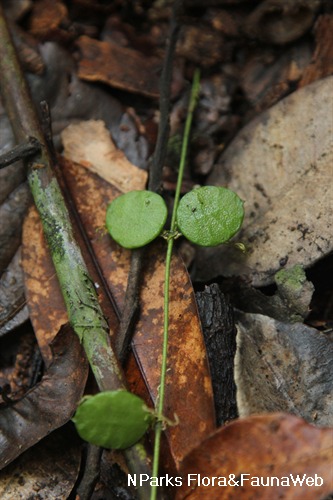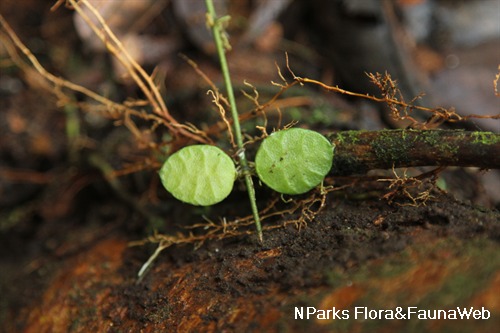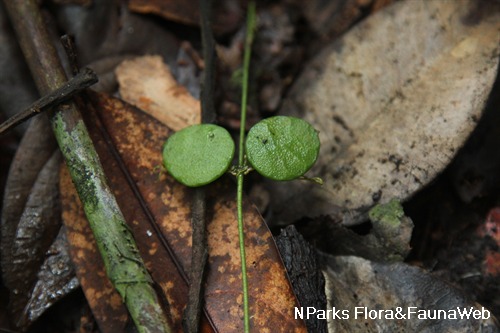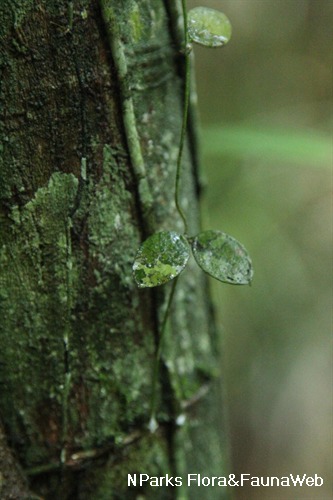
Name
Classifications and Characteristics
| Plant Division | Angiosperms (Flowering Seed Plants) (Dicotyledon) |
|---|---|
| Plant Growth Form | Epiphyte |
| Lifespan (in Singapore) | Perennial |
| Mode of Nutrition | Autotrophic |
Biogeography
| Native Distribution | Myanmar, Indochina, Thailand, Sumatra, Peninsular Malaysia, Singapore, the Philippines, Borneo, Java, Sulawesi, the Moluccas, and New Guinea |
|---|---|
| Native Habitat | Terrestrial (Primary Rainforest, Freshwater Swamp Forest) |
| Preferred Climate Zone | Tropical |
| Local Conservation Status | Native to Singapore (Critically Endangered (CR)) |
Description and Ethnobotany
| Growth Form | It is a creeping, latex-containing epiphyte, with young stems densely covered with hair, occasionally becoming less hairy with age. |
|---|---|
| Foliage | Its latex-containing, opposite leaves have thick, fleshy, leathery leaf blades that are egg-shaped with a round base and pointed tip, green, covered with hair when young, and 1–2.5 by 1–1.5 cm. |
| Flowers | Its flowers are red or dark purplish-red, with pink lobes that are 6 by 5mm long. They occur in clusters of 1–5 flowers on flowering shoots. |
| Fruit | Its green fruits are follicles that split open at one side when mature, linear-lance-shaped, and about 6–7.6 by 0.5 cm. |
| Habitat | It grows on trees in orchards, lowland and hill forests, and on limestone hills. It was rediscovered in 2011 in Upper Seletar Reservoir and Nee Soon Swamp Forest. |
| Associated Fauna | Its flowers are insect-pollinated. |
| Cultivation | It can be propagated by seed and stem cuttings. |
| Etymology | Greek dis, two; Greek askidion, ascidium, alluding to the leaves which may or may not develop into pitchers; Latin hirsuta, hairy, referring to the hair found on this species |
Landscaping Features
| Landscaping | It may be suitable for growing on trees in parks and roadsides. |
|---|---|
| Desirable Plant Features | Ornamental Flowers, Ornamental Foliage |
| Landscape Uses | General, Parks & Gardens, Small Gardens, Suitable for Hanging Baskets |
Fauna, Pollination and Dispersal
| Pollination Method(s) | Biotic (Fauna) |
|---|---|
| Seed or Spore Dispersal | Abiotic |
Plant Care and Propagation
| Light Preference | Semi-Shade |
|---|---|
| Water Preference | Moderate Water |
| Rootzone Tolerance | Shallow Media, Easy to Grow |
| Propagation Method | Seed, Stem Cutting |
Foliar
| Foliage Retention | Evergreen |
|---|---|
| Mature Foliage Colour(s) | Green |
| Mature Foliage Texture(s) | Leathery, Thick |
| Prominent Young Flush Colour(s) | Green |
| Young Flush Texture(s) | Hairy / Hirsute |
| Foliar Type | Simple / Unifoliate |
| Foliar Arrangement Along Stem | Opposite |
| Foliar Attachment to Stem | Petiolate |
| Foliar Shape(s) | Non-Palm Foliage (Elliptical) |
| Foliar Venation | Pinnate / Net |
| Foliar Margin | Entire |
| Foliar Apex - Tip | Mucronate |
| Foliar Base | Rounded / Obtuse |
Floral (Angiosperm)
| Flower & Plant Sexuality | Bisexual Flowers |
| Flower Colour(s) | Purple, Red |
|---|---|
| Flower Grouping | Solitary, Cluster / Inflorescence |
| Flower Location | Axillary |
| Flower Symmetry | Radial |
Fruit, Seed and Spore
| Mature Fruit Colour(s) | Brown, Green |
|---|---|
| Fruit Classification | Simple Fruit |
| Fruit Type | Dehiscent Dry Fruit , Follicle |
References
| References | Rodda, M.. 2012. Rewriting the Record Books. My Green Space. 1/2012. 12. |
|---|
Image Repository
Others
| Master ID | 31255 |
|---|---|
| Species ID | 5650 |
| Flora Disclaimer | The information in this website has been compiled from reliable sources, such as reference works on medicinal plants. It is not a substitute for medical advice or treatment and NParks does not purport to provide any medical advice. Readers should always consult his/her physician before using or consuming a plant for medicinal purposes. |




.jpg)
.jpg)
.jpg)
